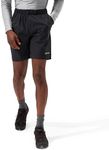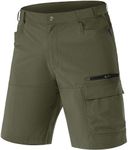Buying Guide for the Best Mens Hiking Shorts
When choosing men's hiking shorts, it's important to consider factors that will enhance your comfort and performance on the trail. The right pair of hiking shorts should offer a balance of durability, comfort, and functionality. Consider the type of hiking you plan to do, the climate, and your personal preferences in terms of fit and style. By understanding the key specifications, you can make an informed decision that will keep you comfortable and prepared for your outdoor adventures.MaterialThe material of hiking shorts is crucial as it affects comfort, durability, and breathability. Common materials include nylon, polyester, and blends with spandex for stretch. Nylon is known for its durability and quick-drying properties, making it ideal for rugged trails and wet conditions. Polyester is lightweight and breathable, suitable for warm weather hikes. Stretch blends offer flexibility and comfort, perfect for more dynamic movements. Choose a material based on the climate and terrain of your hikes; for hot and dry conditions, lightweight and breathable materials are best, while for wet or rugged trails, durable and quick-drying fabrics are preferable.
FitThe fit of hiking shorts can greatly impact your comfort and mobility. Fits generally range from slim to relaxed. A slim fit offers a more tailored look and can reduce bulk, which is beneficial for technical hikes where you need to move freely. A relaxed fit provides more room and is often more comfortable for casual hikes or when you need to layer underneath. Consider your personal comfort preference and the type of hiking you will be doing. If you plan on long hikes or hikes in varied terrain, a fit that allows for a full range of motion is essential.
LengthThe length of hiking shorts is important for both comfort and protection. Shorts typically range from mid-thigh to just above the knee. Shorter lengths can be cooler and offer more freedom of movement, which is great for hot weather or when you need to be agile. Longer shorts provide more coverage and protection from brush and insects, making them suitable for trails with dense vegetation. Consider the environment you'll be hiking in and your comfort with exposure to the elements when choosing the length.
PocketsPockets in hiking shorts add functionality by allowing you to carry essentials like maps, snacks, or a phone. The number and type of pockets can vary, with options including hand pockets, cargo pockets, and zippered pockets. Hand pockets are convenient for quick access, while cargo pockets offer more storage space. Zippered pockets provide security for valuables. Think about what you need to carry and how accessible you need those items to be. If you prefer to keep your hands free, opt for shorts with ample and secure pocket options.
Water ResistanceWater resistance in hiking shorts is a feature that can keep you dry and comfortable in wet conditions. Some shorts are treated with a durable water repellent (DWR) finish that helps water bead off the fabric. This is particularly useful for hikes in areas prone to rain or when crossing streams. However, water-resistant shorts may not be as breathable as non-treated ones. Consider the likelihood of encountering wet conditions on your hikes and balance that with your need for breathability. If you often hike in wet environments, water resistance is a valuable feature.
BreathabilityBreathability refers to how well the fabric allows air to circulate, which is crucial for comfort in warm weather. Breathable shorts help wick moisture away from your skin, keeping you cool and dry. Fabrics like polyester and certain nylon blends are known for their breathability. If you plan to hike in hot or humid conditions, prioritize breathability to prevent overheating and discomfort. For cooler climates, breathability might be less of a concern, and you might focus more on warmth and protection.















